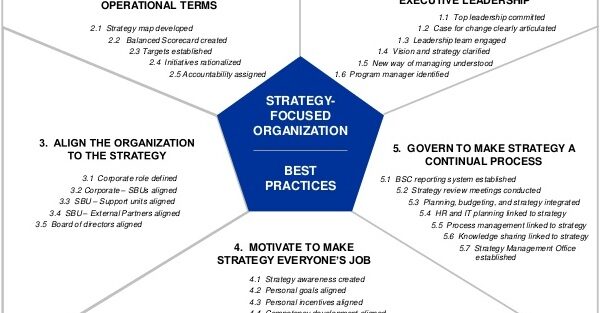Strategy Focused Organization Assessment is a tool to help organization understand its position in implementing its strategy. SFO identify how far organization in the following areas:
- Mobilize change through executive leadership
- Translate the strategy into operational
- Align the organization around its strategy
- Motivate to make strategy everyone’s job
- Govern to make strategy a continual process
<< start the assessment from the blue button at the left side
IN A NUTSHELL
The role of leaders can be traced to the Bible, to Machiavelli in The Prince, and to Sigmund Freud, who said, “Groups depend on a leader for their identity and sense of purpose.” Management scholars—Abraham Zaleznik, Warren Bennis, John Kotter, Ron Heifetz—have urged executives to be leaders, not just managers. They emphasize how leaders have different roles and styles: Leaders foster new approaches and ideas, alter structures and cope with change; managers conserve and maintain stability and order and cope with complexity. Leaders shape moods and ideas and establish direction; managers react to goals. Leaders welcome new options, develop choices, and create new approaches to long-standing problems; choose which decisions get made and how to communicate vision and strategy. Managers, in contrast, keep choices and options down to controllable levels; focus on how decisions get made and communicated. Leaders influence others to voluntarily make day-to-day decisions that enhance the long-term viability; they maintain control through socialization, shared beliefs, norms, values and intrinsic motivation. Managers conduct day-to-day operations: negotiate; rely on extrinsic motivation; organize responsibility by functional areas; conserve assets. Leaders conduct turbulent, intense, future-oriented interactions that involve risk-taking and creativity. Managers interact with people through prescribed roles and hierarchy.
THE FIVE PRINCIPLES OF THE STRATEGY FOCUSED ORGANIZATION
Today’s organizations need executives who can lead and manage. Executives must lead by adapting to dynamic, highly competitive environments, communicating vision and strategy to employees, and inspiring employees to innovate to achieve organizational objectives. At the same time, executives must manage by effectively operating a complex system of interactions to deliver synergies, allocate resources effectively, align reward and incentive systems, and install valid reporting and control systems. Senior executives in organizations that have successfully implemented the Balanced Scorecard achieved success by integrating the roles of leadership and management. We now realize that the success of the Balanced Scorecard lies in its ability to provide a formal, systematic approach for simultaneous leadership and management.
The Strategy-Focused Organization (SFO) framework describes five principles for achieving breakthrough performance with the Balanced Scorecard.
1. TRANSLATE STRATEGY INTO OPERATIONAL TERMS.
Leadership and management themes are central in creating a strategy map and Balanced Scorecard (BSC). Leaders use the BSC to communicate the strategy. Typically, the environment is changing, and the company must adopt a new strategy to succeed. Strategy is about choice. Companies can’t meet the expectations of all their possible customers. Strategy determines which customers the company decides to serve and the value proposition that it offers to win the loyalty of customers.
Describing the strategy via strategy maps and BSC helps leaders develop choices and fresh approaches to problems. Executives introduce new approaches and ideas to cope with change. The process shapes moods and ideas, and sets new directions.
The financial perspective features two strategic themes. The Revenue Growth theme requires leadership to identify the new products and services, new markets, and enhanced value proposition that broadens and deepens customer relationships. The Productivity theme features the management activities that improve the efficiency of existing resources and processes.
2. ALIGN ORGANIZATION TO STRATEGY.
Cascading the strategy down to decentralized divisions, business units and support functions, seems to be primarily a management function. It’s the task of translating a high-level strategy into aligned and integrated strategies at lower-level units. The alignment and cascading, however, allows for leadership to occur much deeper. Rather than dictating the company-level measures down to the operating units, the cascading process encourages each operating unit to define its own strategy—based on local market conditions, competition, operating technologies, and resources—to deliver on strategic goals. The most remarkable transformation occurs in support functions and shared services, such as HR, IT, finance and purchasing. The cascading process transforms support departments from functionally-oriented cost centers into strategic partners of line operating units and the company. By giving support departments the ability to articulate a clear strategy for how they add value, the heads of these units become leaders. They develop a mission and a strategy for their department, rather than just manage to a cost budget.
3. MAKE STRATEGY EVERYONE’S JOB.
In this principle, three processes must be accomplished: 1) communicate; 2) align personal objectives; and 3) link variable pay to scorecard performance.
Communication is clearly a leadership role. Executives use the strategy map and scorecard to communicate the vision, mission, and strategy. Some executives tell us, “You cannot over-communicate; you need to find multiple ways to get the message out. You need to communicate seven times, seven different ways.” Effective, visionary communication helps leaders align and motivate their people. With a clear vision and strategy, everybody learns what the organization is trying to accomplish and how they can contribute. This generates intrinsic motivation. Employees come to work with more energy, creativity and initiative.
Setting personal goals and rewarding individuals for achieving them fall within the management responsibility. The flow naturally occurs from leadership to management. The SFO process enables executives to achieve a seamless integration of their leadership and management roles and align every individual to higher objectives.
4. MAKE STRATEGY A CONTINUAL PROCESS.
This requires executives to: 1) integrate strategy with planning and budgeting; 2) introduce new reporting systems; and 3) lead a new meeting.
In the new integrated planning and budgeting process, the executive team through shareholder, customer and competitive analysis—sets stretch performance targets for the strategic measures, screens strategic initiatives for achieving stretch target performance, and links its strategy to operational improvement programs. These practices help executives deliver on their management responsibilities.
Introducing new information systems for data collection and data reporting also is a central part of managing and implementing new strategies.
Leading a new management meeting means reviewing performance against plan (scorecard measures, not just financial ones); identifying shortfalls (the indicators in the RED zone); and devising solutions to rectify shortfalls. The new leadership processes in the management meeting are the questioning about the strategy, the search for inter-departmental solutions to fundamental problems, and adaptation and evolution of the strategy.
The most effective management meetings use double-loop learning in which executives examine and question assumptions on which their beliefs and strategy are based.
5. MOBILIZE CHANGE THROUGH EXECUTIVE LEADERSHIP.
Executive leaders play three different roles: 1) Mobilization: they communicate the need for change and create the coalition at the top to develop and deploy the strategy via strategy maps and Balanced Scorecards; 2) Governance: they establish the new systems for planning, budgeting, resource allocation, reporting, and the management meeting to reinforce the strategic message and keep the organization focused with adequate resources to achieve strategic objectives; and 3) Strategic Management: the executive reinforces the strategic message at every opportunity, asking “why, what if, suppose that . . . ” to emphasize learning and team problem-solving.
SUMMARY
All aspects of leadership and management become incorporated as organizations apply the five principles. Those who implement their strategies have exceptional, visionary leadership. The CEO leads the case for change, communicates the vision and strategy, and oversees implementation. Without strong leaders, no management system can deliver breakthrough performance.






